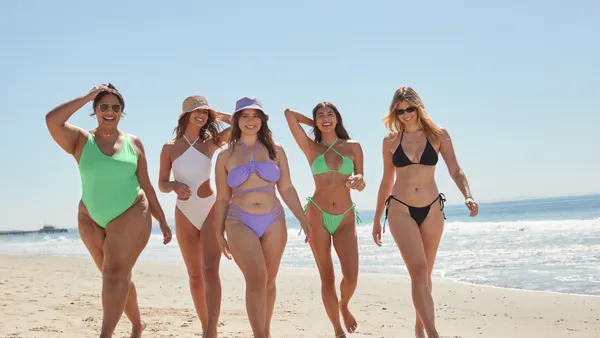Changing jobs can be an intimidating prospect in any year, but the risks have been amplified in 2020 with a pandemic, economic slowdown and fraught political atmosphere. Marisa Thalberg, who joined the retailer Lowe's as chief marketing and brand officer in February, experienced such a situation first-hand. Like so many people, the executive, who built a reputation for digitally transformative work at brands like Taco Bell, became homebound at the outset of the health crisis, putting her thousands of miles away from her new team and organization.
Rather than discouraging the executive, the gauntlet of 2020 has affirmed her belief in the leadership role CMOs can play in times of crisis, while strengthening the brand positioning of Lowe's. The company is in the midst of running a holiday campaign that puts a focus on spending time at home during the season, including by leveraging a relationship with NFL players to deliver pre-lit Christmas trees to families in their hometowns. Deemed an essential business, Lowe's has benefited from some of the societal changes caused by the pandemic as people flee cities for the suburbs and look to spruce up the living spaces where they've been stuck for months on end (Thalberg herself recently bought a house for the first time).
Lowe's U.S. comp sales, a key metric for the retail category, grew 30% in the third quarter, while online sales spiked 130% year-on-year amid a continued consumer shift to e-commerce. The results still fell short of estimates due to climbing investments in areas like digital sales channels — a signal of how Lowe's is transforming in ways that will linger after the pandemic ends. In total, Lowes.com has added 1 million SKUs this year alone, per data shared with Marketing Dive.
Marketing Dive spoke to Thalberg about navigating the trials of 2020 and how the challenges and opportunities of the year carry significant implications for Lowe's future.
The following interview has been edited for clarity and brevity.
MARKETING DIVE: A throughline for Lowe's this year has been a spotlight on the home. You're a home improvement retailer, so that makes sense, but the definition of what 'home' means has changed pretty substantially since March. Could you speak on that?
MARISA THALBERG: It was overwhelming and in some ways profound to step into this role at a moment in our collective history where 'home' has taken on a level of meaning and importance that is — at the risk of using one of most trite words of 2020 — unprecedented. On the one hand, it was an immersion process of trying to learn the brand, the business and the team, but on the other hand, there was really no luxury of time.
Had things happened under a normal timeframe, we would've had the time to really work through some of those decisions on brand positioning. There was a certain amount of experience and instinct guiding those decisions in the beginning, but that's what the role entails.
I always feel like you can't do wrong by really communing with your brand's history and heritage to understand where to take you going forward. What I quickly realized was Lowe's and our associates have always shown up in times of challenge. We were already oriented to do this.
It's interesting how what you're talking about has extended to the holidays, which I know many people associate with home. But it's still pretty bleak in terms of getting people together and from an economic standpoint. How have you recalibrated for the season?
THALBERG: Our peak season, which for other retailers is more typically the time period in which we're in now, came right at the first epicenter of this pandemic in the spring. That really was delicate.
We had to not be opportunistic at a time when the most important thing was to ensure people were going to be safe, both our customers and associates. Of course, that's still the case, but we also have to let them know that we're open. We've learned a lot, and certainly well beyond marketing. Incredible kudos should go to our store operations team, our merchants, our supply chain and our IT team in terms of really rising to this challenge together.
So now, we get to the holiday season, and we did feel it was an opportunity to make Lowe's even more important in regard [to the home] because we are all home for the holidays. How do you cast a positive on that? It's a really important idea to be able to say, yes, we are going to offer you deals and we're going to be present for those people who are shopping, but we can also take it as a moment to reflect communally.
We just used Giving Tuesday to donate $1 million worth of pre-lit artificial Christmas trees. It's just been a time where you have to really connect with your values as a company, your values as a brand. That's been more prominently woven into the fabric of how we've connected this year than perhaps ever before.
Lowe's NFL sponsorship is relatively new. How are you leveraging partners like that as they go through their own disruptions?
THALBERG: Like any other part of society, [the leagues have] all been disrupted and there are lots of question marks. Will the games be played? How will they be played? And then you put that layer of civil unrest on top of it. It's been complicated.
Again, in terms of what it's meant for Lowe's, that's where you have to stay grounded. When we thought about a big organizing idea for how we would partner with the NFL this year, it was almost impossible to resist putting new meaning in home team. It allowed us to do advertising that spoke on that level; to connect with fans and even casual observers. It also allowed us to do something I think is quite important in the NFL, too, which is to use players to tell their personal stories and show them in the context of their own homes.
One of the things we did was organize an additional home team, the Lowe's home team, comprised of a player from each of the 32 NFL organizations. We've used them to share some of the projects they do in their homes, so there's this delightful content around doing more public-service, goodwill projects in their respective communities. This idea of giving back to home in the individual sense, but also in the community sense, just felt particularly pertinent.
Locally based marketing has become more important for a lot of retailers this year, and the NFL campaign gels with that, along with having a purpose aspect. I wanted to take that as an opportunity to ask: What are the biggest ways the CMO role has changed in 2020 and are any of those permanent changes?
THALBERG: We're going to look at 2020 as marketers and say that it was a year where some of these concepts that we've spent a lot of time espousing to each other and at industry conferences — agility, purpose — those all came home to roost. You either were really showing you were about that or not. A big part of it was just putting that into practice: Can you continue to do the right thing commercially and also be the kind of company and brand that knows how to navigate very sensitive waters?
In some ways, the insights were just plugging into the zeitgeist. A week felt like a month and a month has felt like a year in terms of trying to figure it out. That's one part, and then I'd say the other part is more broad than just marketing. I think as leaders, we've all had to figure out what it means to motivate and connect with a team; to drive decisions; to choose to work in this completely virtual environment. For me, bear in mind I was a completely new leader to not only a new team, but a new organization. I spent the first few months 3,000 miles away in Southern California.
It was challenging, but again, this is where I had to give myself a pep talk and say, 'this is leadership.'
The CMO role has gone through a really topsy-turvy few years. I'm wondering if you think that the pandemic, as much as it's added new pressures, has affected its place in organizational leadership?
THALBERG: Of course, I'm biased. I think it's one of the most critical positions in the C-suite. I don't think too many other peers in the C-suite have a level of community that I feel with my fellow CMOs.
In the beginning [of COVID-19], many of us were on different Zooms talking and sharing notes. I take so much strength from that, the idea of leaders like this being empowered in their respective organizations. I don't know for sure that that's a change, per se, but if it were, I would say it's only a good thing because I think the best CMOs bring this very unique perspective of understanding the intersection of business, consumer psychology and culture. Very few roles do that and can bring that right- and left-brain thinking. I'm passionate about a hope this will be a positive moment for what CMO leadership brings in the corporate world.
I'm glad you mentioned the intersection of business and consumer psychology. Because, as much as the pandemic has changed messaging priorities, it's also changed business levers like e-commerce. What's the learning curve?
THALBERG: We're a retailer and thank goodness a lot of fundamental work was already underway in strengthening our omnichannel capabilities. We were fortunately much better poised than Lowe's would've been a couple of years back to accommodate much higher levels of dot com traffic, sales and moving fast on institutionalizing certain capabilities like buy-online, pick-up in-store.
Of course, it's a big role within marketing to be looking at how we market total omnichannel experiences at Lowe's, how we drive traffic-to-conversion to our dot com business, how we really think about the totality of not just selling what we sell, but also selling our services.
In home improvement, there are really two important types of consumer groups: One is the general DIY consumer, but we also have the pro customer. I really saw the onset of the pandemic as an inflection point for them as well. You have to think with empathy as people: What are they experiencing right now? Has a lot of worked slow for them? How can we have their backs in times of crisis, because that's when relationships get fomented?
More retailers are thinking about stuff they can do with their combination of in-store and online data, like betting bigger on media networks. How has your thinking evolved there?
THALBERG: That's an area of continued growth and opportunity for us in terms of better connection of data and using that to just be smarter, more efficient and more effective in how we connect with customers. I think we have a lot of work to do on that, but it's certainly on our minds.
Looking forward into 2021, there's positive vaccine news, it seems like second-half next year things could start to get back to normal. What are you preparing yourself for?
THALBERG: One of the things that I'm most excited about, putting the larger issues [aside], is that Lowe's is about to celebrate its centennial in 2021. It just seems like an incredible moment of reflection. How do you use such a turning point to say who've been and who we want to be for the next 100 years?
I'm excited to celebrate that in a meaningful way with the brand and continue to drive some of the preexisting behaviors, but also some of the new behaviors in terms of caring for and investing in home that the pandemic perhaps has inspired. I think there's a lot underneath the Lowe's gable that's surprising and I get excited to share more of it as I learn more and more of the story.
Clarification: This story has been updated to more clearly explain the focus of Lowe's holiday campaign. It is centered on spending time at home during the holidays.













